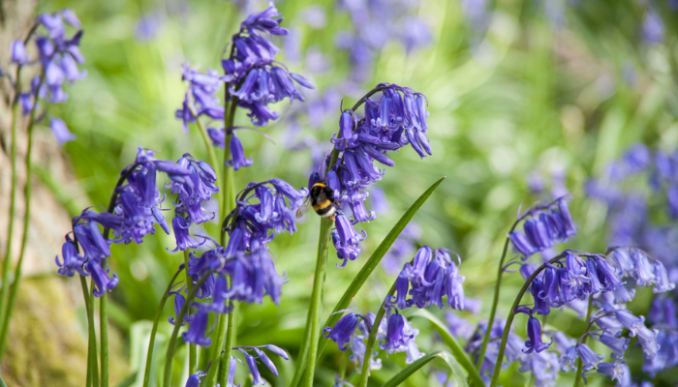E-Newsletter Signup
For special offers, updates and news of new products join our newsletter.
- Also in Blogs
- Sustainable Camping: Preserving Nature for Future Generations
- Embracing the Renewal of Spring: Camping Adventures Await.
- Beating The Winter Blues!
- The History of Cycling
- Senior Camping: Young at Heart
- View all posts in this category >>
GUEST BLOGGER
If you would like to contribute to our blog as a guest and can bring fresh outdoor experiences, please:
Breathtakingly Beautiful Bluebells
Posted in Blogs on 14th April 2023
There’s nothing quite as beautiful as an English wood in full bloom. A carpet of bluebells is one of nature’s most magical sights, so when they start emerging through the ground every Spring, it’s something every nature lover should witness.
Perennial flowers, bluebells bloom every year. While the season lasts from late March until early May, the average date for them to start flowering in the UK is 14th April, according to the Woodland Trust.

What do bluebells look like?
English bluebells have bell-shaped flowers. They live underground as bulbs, before emerging in large numbers to create a magnificent blue carpet that stretches across our British woodland every year.
With narrow leaves, that are around 45cm long and up to 25mm wide at the thickest part, tapering to a pointed tip, the flowers are a deep blue-violet colour, each with six petals. The flowering stem nods over to one side, giving them their distinctive bell shape. Their sweet aroma is much loved and admired by woodland walkers and country campers.
Our native English bluebells shouldn’t be confused with the intrusive Spanish variety, which looks similar, but grows straight up, rather than hanging over to one side. Never plant Spanish bluebells, because they will compete with the native English species and dilute the natural gene pool. A hybrid species has already been growing in the UK and there’s a danger it will diminish the numbers of native plants.
Poet’s inspiration
Famous 19th century English novelist and poet Anne Brontë, a native of Haworth on the Yorkshire moors, was inspired to write a verse about these beautiful blooms:
A fine and subtle spirit dwells
In every little flower,
Each one its own sweet feeling breathes
With more or less of power.
There is a silent eloquence
In every wild bluebell
That fills my softened heart with bliss
That words could never tell.
Composed on 21st August 1838, when the author was only 18 years old, this beautiful poem was first published posthumously in 1902, long after Ann’s death.
In what areas can you find bluebells in the UK?
Traditionally woodland flowers, bluebells usually grow very close together, creating the stunning sea of blue that we know and love.
Most prolific growing in the naturally rich, undisturbed soil of long-established woodlands, they can also often be found lining country roads and in hedgerows. If you’re hoping to see some this Spring, you’re most likely to find them in ancient woodland.
It’s well worth a trip to some of the UK’s finest old woodlands to see the breathtakingly beautiful bluebells in bloom. The Woodland Trust has put together a list of the finest wild sites in the four home nations:
In England, it suggests Tattershall Carrs in Tattershall, Warriners Wood in Kendal, Mason’s Wood in Preston and many more.
Other bluebell woods of note include Scotland’s Dunollie Wood in Oban, Wales’ Coed Gwempa in Pontantwn and Northern Ireland’s Drumnaph Wood in Maghera County, Londonderry.
You can also spot bluebells growing wild in fields and in country gardens.
Are bluebells protected in the UK?
Our native English bluebells are a protected species under the Wildlife and Countryside Act 1981. It is illegal to dig up wild bulbs without the landowner’s permission. Similarly, the landowner can’t dig them up for the purpose of selling them.
The Woodland Trust urges people to help protect native bluebells by always remaining on the path during woodland walks to avoid trampling them. Delicate blooms are damaged easily and this can impact future growth. It takes more than five years for a patch of bluebells to establish itself and if they are trampled, it can be a while before the plant fully recovers.
Are bluebells of any value to wildlife?
A major source of nectar for bees and other pollinating insects, bluebells are an important part of our ecosystem. Losing our natural bluebell woods would have a detrimental effect on wildlife.
Even though you’re welcome to take a trip to woodland areas and enjoy the fragrant display, the Woodland Trust advises that visitors should NEVER pick bluebells to take them home.
Are bluebells endangered?
The Forestry Commission has warned that we must protect our bluebell woods so future generations can continue to enjoy them. The organisation says the landscape is changing and our native woodland could be negatively impacted over the next two decades if we don’t take greater care of it.
The encroachment of urbanisation on rural sites, pollution and an invasion of Spanish bluebell varieties could all contribute to the demise of the English bluebell. This would mean the native flower would be less prolific, with a weaker scent and less vibrant blooms – something no-one wishes on our woodland wonderflower.
A study by the Forestry Commission found the pure English variety is being replaced in some areas by “hybrid invaders”, which have spread into areas adjacent to ornamental and suburban gardens, where Spanish bluebells were planted in recent decades because they were easier to grow.
The commission suggests planting pure English bluebells in your own garden to help ensure the widespread future of this British botanical beauty.



